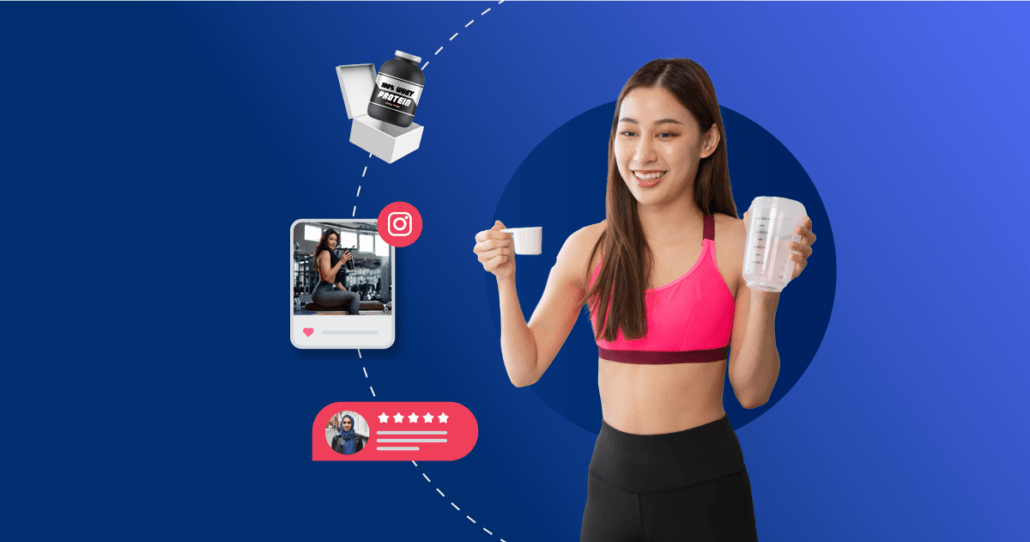October 10, 2024
If there’s one truth about marketers, it’s that we see trends come and go. (Remember when all we cared about was Likes and follower numbers? Remember flash mobs?) But one trend that’s proven to be more than just an industry buzzword is influencer marketing. Influencers are here to stay — and if anything, we will see even more growth in the rest of 2024 and 2025.
It makes sense. 67% of shoppers now rely on UGC for shopping inspiration and fact-finding—a big piece of this is influencer content. When done right, influencer marketing feels unbranded and creates an authentic, trustworthy rapport with audiences. This is good news for shoppers who want (seemingly) unbiased takes on products and great news for brands.
Brands are continuing to respond to this demand. In 2023, influencer marketing spending was $34 billion globally, up from $29 billion in 2022. And the numbers are still climbing.
In this article, we’ll examine the continual growth in influencer marketing trends and some brands that are doing it right.
“Influencer”: It’s Time to Update Our Definitions
Before we leave the subject of “obsolete marketing stuff,” here’s something to consider: it used to be that “influencer” meant “a celebrity with a reality show, a fashion line, and a bajillion followers.”
Is that trend dead and buried? Absolutely not — and if you can partner with a Kardashian, more power to your brand.
What is happening, however, is that the definition of what constitutes “influence” is broadening to include people at every economic, social, and follower level.
And interestingly, this redefinition is powered by consumers. Shoppers are increasingly turning to smaller influencers and everyday creators — aka people who look like shoppers — for their recommendations and takes. In a recent survey, we discovered that while 42% of customers would buy products recommended by everyday social media users, only 7% would follow a celebrity recommendation.
There’s even a new taxonomy for influencer size, which is helpful to know when you’re planning an influencer campaign and thinking about cost-per-engagement:
- Everyday social media users
- Nano-influencers (1K–10K followers)
- Micro-influencers (10K–50K followers)
- Mid-tier influencers (50k – 200k followers)
- Macro influencers (200k – 500k+ followers)
Now that we’ve met all these new influencers, let’s check out the industry conditions keeping them in your feed. (And in all those sample products. We’re not jealous! You’re jealous!)
People are tired of your ads
In an era when people routinely spend hours scrolling, they will see a lot of ads.
Or, more accurately, they won’t because the ubiquity of ads has created what’s known as “banner blindness,” where the eye glazes over when shown ad units and brand posts. We’ve effectively trained consumers to stop paying attention.
Influencers change all that.
To start with, influencers are already in your social feed; whether big or small, they’re someone you follow because they’re, well… interesting. The product that gets introduced is part of their life, so it seems to enter your feed organically. Then they can test it, use it, and live with it — all on camera, at home, showing the product in a much more relatable setting than your shiny 0:30 YouTube pre-roll.
It’s a seamless way to get products into the feed. It’s eye-catching, entertaining, and pre-programmed to stand out. And when done right, it doesn’t feel like a bait-and-switch: the content comes from a real person who’s passionate about sharing what they know.
Here’s just one example: Bemz, a Scandinavian design company, uses influencer content to show real-life applications of its products, which has led to a 41% increase in click-through rates.
Whether you’re a shopper or a brand, it’s kinda hard to be fatigued with that.
The great Gen Z hunt
They make up approximately 2 billion of the global population. They have over $360 billion in disposable income. And they single-handedly made skinny jeans go extinct.
It’s hard to overestimate Gen Z’s clout. Every brand worth its marketing budget is competing for their attention. It means having a solid social media presence: 67% of Gen Z start their shopping search on platforms like Instagram and TikTok.
But not all social content is created equal. When it comes to Gen Z, you have to contend with ad fatigue, plus its famous, generation-wide preference for the authentic over the branded, the homemade over the slick, the transparent over the legal department-approved.
Here again, influencers are paving the way by providing consumers with a real, relatable, human voice. Moreover, Gen Z will gravitate to influencers who embody their values, like social responsibility and sustainability, and these influencers can organically build a level of trust with shoppers that brands and even some celebrities simply can’t.
Quiz, a global fashion brand, learned this lesson when it harnessed the power of both micro and macro-influencers to enhance engagement during the COVID-19 pandemic. This strategy resulted in a 276% increase in time spent on their site and a 154% rise in conversion rates.
Gen Z’s purchasing power will only grow; with it, every brand needs to forge authentic connections. Our advice: leave it to the pros.
Bye-Bye, Barriers
To some degree, we’re preaching to the converted here. Influencer marketing has seen steady growth since the 2010s. And one result of this growth — and a factor for its continuing climb into 2025 and beyond — is that campaign management is simply easier now than it used to be.
Given the sheer number of influencers and content creators (some estimates are as high as 300 million globally), finding, filtering, and connecting with the perfect influencer seems like it should be a handful.
But the reality is that the industry has matured somewhat — and now boasts technology to remove any friction from the process. Meet the influencer marketing platform, an automated software package that helps you:
- Search for and locate influencers aligned with your brand
- Manage campaign tasks, progress, and approvals
- Monitor content in real-time
- View detailed analytics to gauge how the campaign is performing
- Manage creator payments globally
The entire process is streamlined, removing the barriers between you and influencers — so you can remove barriers between your influencers, your audience, and your products. Best of all, eliminating that manual outreach leaves you time for more valuable activities.
(If you’re interested in learning more or don’t know where to start, we’ve put together a handy beginner’s guide to influencer marketing platforms — including some platforms we love.)
Measure, optimize, repeat
We mentioned analytics above, and it’s worth remaining on the point.
Among some marketers, there’s a perception that the effectiveness of influencer marketing can be difficult to measure. Suppose you think about our past over-reliance on vanity metrics (including the likes and purchased followers mentioned above). In that case, you can see where some confusion originated, mainly if you hoped to see a tangible ROI, like conversions.
Luckily, today’s influencer marketing platforms are taking the guesswork out of campaign effectiveness. Advanced tracking and measurement tools are lifting the hood on influencer engagement so you know minutely how it works. These tools can capture estimated reach, impressions, engagement, and conversion rates as the campaign runs, earned media value (EMV), sentiment analysis, and the all-important ROI post-campaign.
Additionally, platforms can generate unique affiliate links and promo codes for influencers, making tracking sales and conversions directly attributed to their efforts more manageable.
Taken together, that’s a whole lot of data. And a lot of insights you can use to optimize for the future.
(And, of course, a campaign will only succeed by defining the metrics you want to see. Are you trying to build awareness? Drive sales? Increase social engagement? These are all different campaigns and might require different influencers. Truly effective measurement starts when you know what you’re measuring.)
Where do you want to be in 2025?
Since Influencers are transforming the way brands can interact with their audiences, they’re a powerful tool in a marketer’s tool belt. And for the time being, they’re here to stay. If success in 2025 means cutting through the noise, connecting with shoppers in an authentic, relatable way, and streamlining your work processes (and we believe it does), it might be time to make influencers part of the equation.
For more detailed insights and examples, check out this full article on Bazaarvoice: The ultimate brand guide to influencer collaboration.





